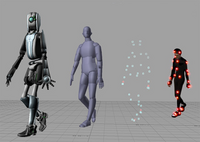
Photo from wikipedia
In this letter, we present a novel approach for predicting pedestrian crowd dynamics over longer time horizons (30 s). In dense environments over long time horizons, the number of pedestrian… Click to show full abstract
In this letter, we present a novel approach for predicting pedestrian crowd dynamics over longer time horizons (30 s). In dense environments over long time horizons, the number of pedestrian interactions is high, leading to the degradation of traditional pedestrian trajectory estimation techniques. Alternatively, we consider the macroscopic properties of the crowd as a whole, focusing on the flow of density. This approach benefits from not considering pedestrians individually, and can probabilistically estimate the existence of previously unobserved individuals. We propose a novel approach to imposing a physical constraint on the crowd density flow. Initially, a coarse resolution prediction is generated by a Convolutional Recurrent Neural Network (ConvRNN), and subsequently smoothly interpolated by a Gaussian Process (GP). Using the linearity properties of GPs, a continuous representation of the crowd is produced that complies with both the ConvRNN’s prediction and a conservation of density constraint. The approach is trained and analysed on the dense ATC dataset, where we show the advantages of the approach and the improvements from our contributions.
Journal Title: IEEE Robotics and Automation Letters
Year Published: 2022
Link to full text (if available)
Share on Social Media: Sign Up to like & get
recommendations!